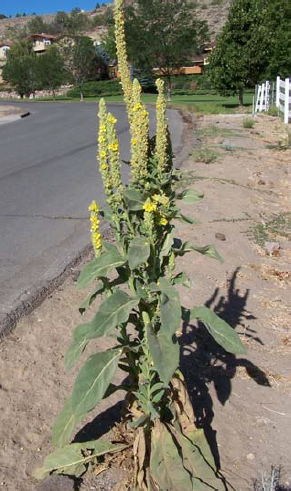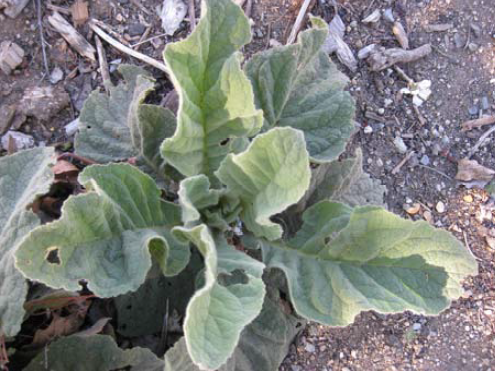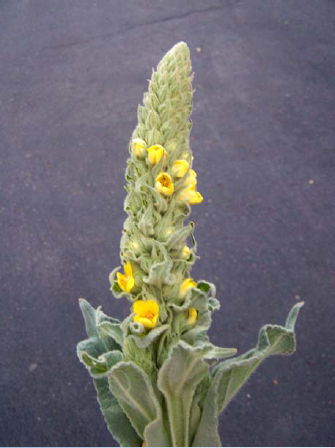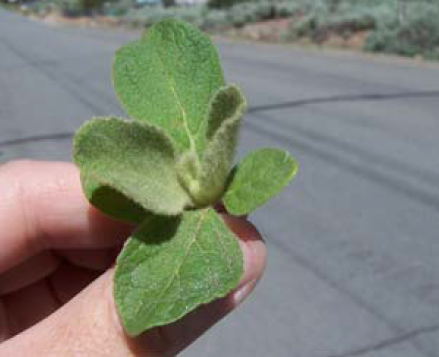Other common names
Wooly mullein
Scientific name
Verbascum thapsus
Family
Scrophulariaceae
Description
A tall plant with pale fuzzy leaves and long flowering stalks, common mullein grows in a rosette (groundhugging form) in the first year, and then as a tall, flowering plant in the second year.

Typical plant growing in disturbed site.
Leaves
Hairy, felt‐like and pale green to silvery in color; range from 4 to 12 inches or more in length. Leaves are larger below and smaller higher up on the stem.

The leaves are large with prominent veins. In the first year, mullein grows in a rosette (ground‐hugging form), shown here.
Stems
Produces a single large stem up to 6 or more feet tall.
Flowers
Yellow with 5 petals; up to an inch in diameter. Flowers open randomly along the branched flower spikes. Blooms from summer to fall.

Flowers are yellow and open randomly along the flower stalk.
Roots
Has a bulky but somewhat shallow taproot.
Native to
Asia; came to the United States via Europe; naturalized throughout the United States
Where it grows
Pastures, meadows, vacant lots and other disturbed or unmanaged sites. Mullein is well‐suited to gravelly soils and will grow in both moist and dry sites.
Life cycle
Biennial (flowers and dies in the second year)
Reproduction
Reproduces by seed

Rosettes have soft, fuzzy or wooly leaves.
Control methods
Common mullein is a prolific seed‐producer, and a single plant can result in a large infestation the following year. Plants are most easily removed when they are small seedlings or rosettes.
Mechanical
Dig, hoe or pull young seedlings. Plants are easy to pull. Use mechanical control methods prior to formation of flowers and seeds. If the flower stalk is cut, a plant will grow new stalks and flower again, so this is not an effective method of control.
Cultural
Plant desirable vegetation that will shade the area and reduce germination and growth of young plants.
Biological
The mullein seed‐eating weevil, Gymnetron tetrum, has been used successfully in some parts of the United States. Permits are required to introduce biological controls from other areas. Livestock do not eat mullein because of its fuzzy leaves.
Chemical
Apply broadleaf‐selective herbicides on young plants. Add a surfactant according to label directions to aid uptake by the fuzzy leaves.
References
All photos by S. Donaldson
- DiTomaso, J.M. and E.A. Healy. 2007. Weeds of California and Other Western States. University of California Publication 3488.
- Remelay, T. 2005. Common Mullein. Plant Conservation Alliance’s Alien Plant Working Group, NPS.
- USDA Forest Service Forest Health Staff. 2006. Common Mullein, USDA
- Whitson, Tom D. (editor). 2002. Weeds of the West. University of Wyoming, Jackson, Wyoming.
Donaldson, S. and Hanson Mazet, W.
2010,
A Northern Nevada Homeowner’s Guide to Identifying and Managing Common Mullein,
Extension | University of Nevada, Reno, FS-10-22


